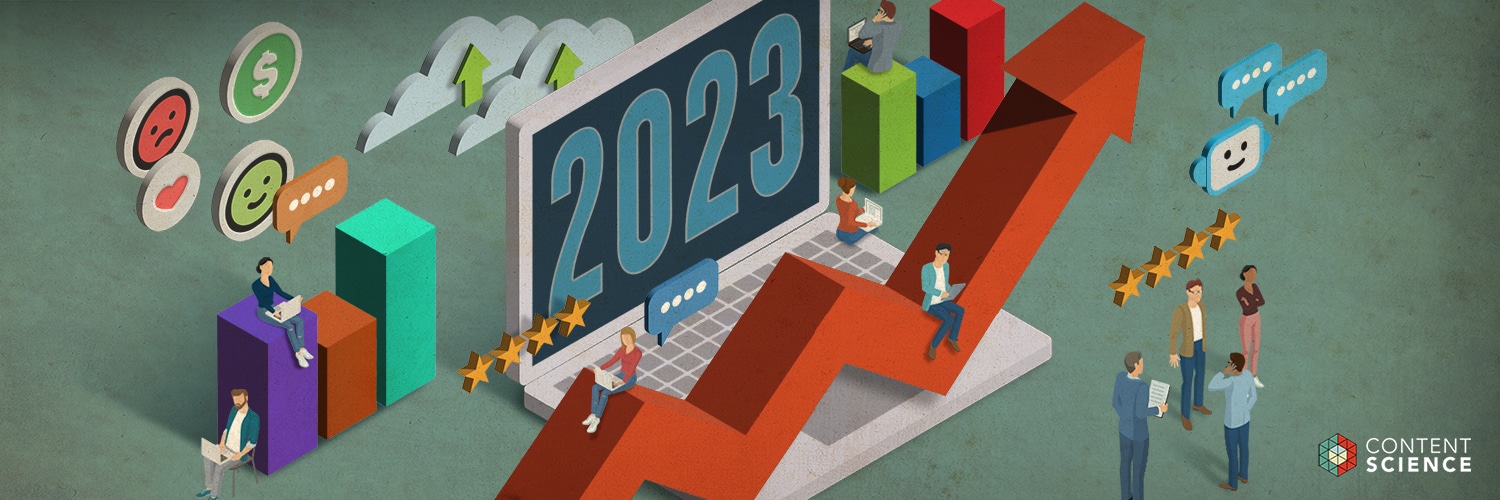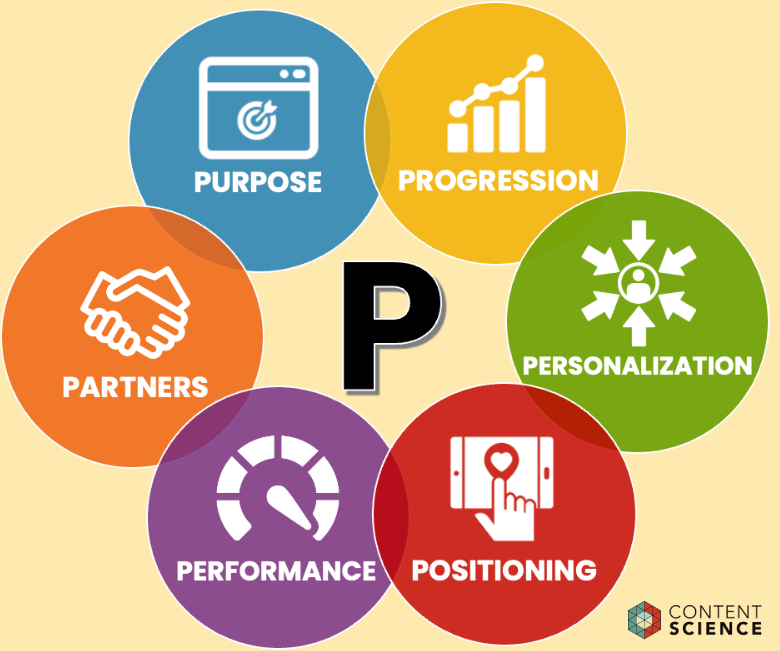
Editor’s Note: This is the second in a two-part series about the state of content based on highlights from Content Science’s annual webinar.
As professionals, we’re all finding a way to operate in a time of manic extremes. (Learn more about the content extremes and trends driving them in part one of this series.) The opportunities are bigger than ever before—and so are the challenges. My hypothesis is an evolved set of content principles can help leaders navigate, and I’m excited to share principles developed by the Content Science team and me…along with some smart quotes and handy examples.
But first, let me briefly share the theory driving this hypothesis.
Theory: A Big Content Bang
I believe we’re operating in, or just after, something like a big content bang. Trends such as the technology booms and busts are forming new elements to build amazing content and experiences. The rise of Gen Z and acceleration of digital disruption are making content demand and opportunity expand rapidly. And, like the mysterious dark matter in our universe, there’s a dark side such as political extremism and competing visions of the web that’s being revealed as we go.
With that and the trends at work in mind, the Content Science team and I developed principles to respond.
The Content Principles: 6 Ps for 2023
Regardless of whether you play along with my theory, my intent is you find value in these 6 content principles. Use them alone or in combination to make the most of our current content state and mitigate the worst.

So, let’s take a closer look at each content principle.
1. Purpose
Purpose means clarifying your organization or brand’s purpose while helping users achieve theirs. Pay attention to purpose this year because
- Causewashing won’t work.
It’s time to communicate purpose uniquely, genuinely, and repeatedly to inspire employees and customers. - Siloed experiences won’t work.
Content must be fit for purpose in end-to-end employee and customer experiences. - Lip service to diversity, equity, and inclusion won’t work.
Accessible + inclusive language used consistently across experiences shows commitment. - Reputation complacency won’t work.
Monitor mentions, dark web, communities, and more. And be ready for the worst.
I’ll share a brief example, starting with a question: What do Content Science and Patagonia have in common? If you answered we both like athleisure wear and to be outside, you would not be wrong. But what I want to point out is we both made the 2022 Inc Best in Business List. (To be fair, Patagonia made the tippity top of the list as Company of the Year.)
How could this happen? Because we both have purpose. Patagonia’s purpose has received widespread coverage over the past year, so I assume you’re familiar. I’ll briefly share the purpose of Content Science.
Experience the delight of enabling worthy organizations to make content make a constructive difference in how people feel, decide, act, and live.
That purpose has many implications. One is we fight disinformation and misinformation as best we can, such as
- Donating quarterly to nonprofits such as Pew Research, CDC Foundation, Politifact, and News Literacy Project and promoting their research
- Giving subscriptions to quality news and media to our team members.
- Covering the topic with high standards here in Content Science Review.
I’m excited about finding ways to do more. My point here is we do much more than pay lip service to our purpose, and that’s what your organization will need to do, too.
At the same time, companies will need to make content better meet its purpose for customers and employees. That means better understanding customer needs across end-to-end experiences, as VP Jerele Neeld of Dell explains.
Designing content fit for purpose and helpful to people at the moment of need remains critical every year. It will be so this year. Understanding how the consumerization of technology affects the expectations of business audiences and technology users (mobile-first of years prior, cloud computing model now, and AI and augmented/mixed reality of coming years) will remain a focus. Measuring the performance of all content types and deriving actionable insights that can be easily operationalized needs attention every year, and will again this year. Finally, doing an even better job of making our content easy to find and eliminating confusing and duplicative content will be a priority.
2. Personalization
Personalization is probably not a new idea to you. But it becomes more important now as channels for promoting content change and even become unstable and Gen Z expects effective personalization in end-to-end experiences. What I want to emphasize here is the need to clean up the data driving personalization and structure the content to support it. In 2023, organizations will need to let go of some old ways of doing things because…
- Relying on third party data won’t work.
Build trust directly with customers (see principle 1), evaluate content effectiveness, treat the data with care, and use it (first party data) to tailor content creation + delivery. - Content blobs really won’t work.
Model content at the right level of granularity to personalize for the cohort or the context. - One version fits all won’t work.
Plan on creating and managing variations of your assets and multiple states of your screens. - Ignoring email + notifications won’t work.
Use them to provide deep links to relevant content, helpful reminders, pertinent updates, and more. Use the rich first party data in content decisions.
As a helpful example of both personalization and purpose, check out this case study by John Collins of Atlassian. And the good news is technology innovations such as customer data platforms, headless CMS, and advanced DAM fueled by artificial intelligence can help. I like how Senior Director Toni Mantych of ServiceNow articulated the potential in one of our recent conversations:
With companies and organizations continuing to prioritize enabling their customers and members to be self-sufficient, AI-driven predictive—and prescriptive—content will continue to be the holy grail, and a differentiator for customer experience. Organizations will continue to get better at proactively providing content based on user characteristics and other contextual parameters.
Learn more about content technology trends here.
3. Positioning
By positioning, I mean making content easier to find and access. In a time of channel instability, more content than ever, and Google continuing to tune its algorithm to content quality and voice queries, your organization’s approach will need to evolve. In 2023…
- Skimping on content quality won’t work.
Make content accurate, useful, relevant, and accessible. Delete low quality content. - Covering the same basics won’t work.
Go deep. Match user intent. Develop topic clusters. Help customers judge and decide. - Poo-pooing FAQs won’t work.
Embrace the Q+A structure as fundamental to voice search and Google featured snippets
- Metadata as an afterthought won’t work.
Craft effective metadescriptions. Align structure with substance.
And if Microsoft’s bid to make Bing competitive means Bing tunes more effectively to quality than Google, then all of the above will put you ahead on optimizing for Bing, too. (If Google is taking the competition seriously enough to launch a ChatGPT alternative, we should.)
For a useful example of improving content quality and structure for big impact, check out this case study with a home improvement retailer.
Perhaps somewhat ironically, optimizing the position of your content actually requires more strategy than ever. Take a cue from VP of Content Strategy Wade Coleman of Fiserv
As we enter a new year, the role of content strategy remains vitally important. We keep our organizations focused on people: educating, influencing and inspiring our audiences and organizations. Let’s welcome the robots and put them to work by making us better at creating meaningful value, not just more stuff.
4. Progression
Progression is about expanding your content strategy or set of strategies, maturing your content operations, and stepping up in leadership to support end-to-end experiences. This P will serve you well because if you work for a large or even a midsize organization…
- A single content strategy won’t work.
Set a content vision, align supporting strategies, and integrate resources to execute with a center of content excellence. - Manual or ad hoc content operations won’t work.
Scale by bringing together modern roles and advanced technologies while expanding processes to factor in data. - Old ways of leading content won’t work.
The impact and value of content today is unprecedented. So is the complexity of the context.
In a recent conversation, VP of Content Marketing Center of Excellence Steven Pritt of Thomson Reuters hit on why aligning strategies must happen.
There is no doubt that content plays a crucial role in marketing, but lines are getting grayer where marketing begins and ends. Content must be interwoven in Marketing, CX (customer experience), and BX (brand experience), and it must all work together.
For more about what sets outstanding content leaders apart, I explore 3 key characteristics in this article. And if you’re interested in more about progression, I share 10 books to add to your reading list here.
5. Performance
Performance is about assembling and using content intelligence to make better content decisions faster. This principle is crucial not only because of the intense demand for content but also because of the pressure for realizing more value from content. In 2023…
- Web analytics alone won’t work.
Include other data such as channel analytics, business analytics, voice of customer data, and competitive data. This data not only tells a more complete story about content performance, it also helps build reliable first party data. - Reports without insight won’t work.
Create meaningful reports and dashboards that tell the story and answer the question, “So what?”. - Slow content decisions won’t work.
Make reviewing and acting on content intelligence part of your process, not something someone tries to do in their spare time. - Avoiding ROI won’t work.
Have the courage to look for correlations between content effectiveness and ROI.
We talk about measuring the effectiveness or impact of content often at Content Science Review. That’s because we study early adopters and have found a strong correlation between evaluating effectiveness and reporting both more content success and fewer content challenges.

For example, performance is a priority for 3 content leaders at AT&T, Jonelle Wilkinson-Seitz, Colby Phillips, and Meredith Deaver. And I love how they relate the value to important elements of purpose, such as being inclusive.
In challenging economic times, we see a growing focus on demonstrating the value of content in de-risking projects and driving ROI. With a new position in our organization and growing access to business analytics, we plan to build enterprise-level processes that drive cohesion and emphasize consistency. All while ensuring our content remains inclusive, in language and practice.
Now, let’s turn to the last P.
6. Partners
The sixth and final P is Partners. Lean across silos within your organization and work well with outside partners who are entrepreneurial because…
- Trying to do it all yourself won’t work.
Leaders have to focus on being experts in the business, developing the right relationships, and communicating progress. - Ignoring specialist insight won’t work.
Hire modern content roles and bring in outside specialty expertise as needed. - Picking the wrong partners won’t work.
Pick platforms, agencies, consultancies, and others that are innovating and growing with purpose. - Monopolizing won’t work.
The antitrust sentiment is strong, so the companies in which content professionals lead must partner.
McKinsey’s Miklos Dietz recently observed that
Most ecosystems will not be ruled by one gigantic company…Most ecosystems will be orchestrated by a partnership with partners of very different roles. It is a multifaceted, multidimensional dance and choreography through which they find their natural roles.
I’ve considered closely what it means for Content Science to be a good partner—both with clients and with other amazing firms pushing for progression—because it’s part of why we earned that Inc Best in Business distinction. You can check out the best of those thoughts here. (Yes, there are Star Wars references.)
You also might find it useful to check out this diagram summarizing why content leaders connecting with innovative partners will create tremendous value now, which I shared at the recent Kontent Horizons event by Kontent.ai.
And, finally, consider whether your organization is being a good partner to your customers or audiences and how that can improve your content, as this quote from Pritt suggests
In 2023, B2B businesses will need to exhibit that they understand their customer’s needs, not simply talk about their needs through pain points in the content they create. Using content to showcase that a business genuinely understands their customers, not just their pain points, will see better engagement, trust, and loyalty because the customer will see you as a partner, not a supplier.
So, we have come to the end of the content principles. For more supporting data and examples of each one, check out the full State of Content webinar recording.
A Recap
Thanks to a number of trends, we’re seeing the best and worst of content times. And that means both amazing opportunities and complex challenges for any organization with the courage to deal with content differently in 2023. The great news is you don’t have to go into the year unprepared or tackle it alone. By embracing the 6 content Ps, I’m confident you’ll expand the impact of your content and your career despite the inevitable obstacles. And I can’t wait to hear how far you go.
If you can build trust with your customers or audiences and your employees in a time of uncertainty, you will have an invaluable asset that will bring you precious returns.
-
Events, Resources, + More
The Ultimate Guide to End-to-End Content
Discover why + how an end-to-end approach is critical in the age of AI with this comprehensive white paper.
The Content Advantage Book
The much-anticipated third edition of the highly rated book by Colleen Jones is available at book retailers worldwide. Learn more!
20 Signs of a Content Problem in a High-Stakes Initiative
Use this white paper to diagnose the problem so you can achieve the right solution faster.
Upskill with Content Science Academy
Training for modern content roles through on-demand certifications + courses or live workshops.






Comments
We invite you to share your perspective in a constructive way. To comment, please sign in or register. Our moderating team will review all comments and may edit them for clarity. Our team also may delete comments that are off-topic or disrespectful. All postings become the property of
Content Science Review.